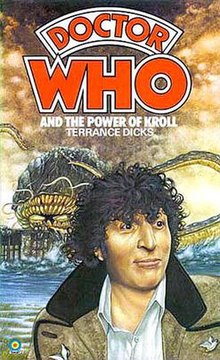The Power of Kroll
| 102 – The Power of Kroll | |||||
|---|---|---|---|---|---|
| Doctor Who serial | |||||

|
|||||
| Cast | |||||
|
Others
|
|||||
| Production | |||||
| Directed by | Norman Stewart | ||||
| Written by | Robert Holmes | ||||
| Script editor | Anthony Read | ||||
| Produced by |
Graham Williams John Nathan-Turner (uncredited) |
||||
| Executive producer(s) | None | ||||
| Incidental music composer | Dudley Simpson | ||||
| Production code | 5E | ||||
| Series | Season 16 | ||||
| Length | 4 episodes, 25 minutes each | ||||
| Originally broadcast | 23 December 1978 – 13 January 1979 | ||||
| Chronology | |||||
|
|||||
 |
|
| Author | Terrance Dicks |
|---|---|
| Cover artist | Andrew Skilleter |
| Series |
Doctor Who book: Target novelisations |
|
Release number
|
49 |
| Publisher | Target Books |
|
Publication date
|
26 May 1980 |
| ISBN | |
The Power of Kroll is the fifth serial of the 16th season in the British science fiction television series Doctor Who, which was first broadcast in four weekly parts from 23 December 1978 to 13 January 1979. It is the fifth and penultimate story in the Key to Time story arc.
The Fourth Doctor and Romana have arrived on the third moon of Delta Magna, searching for the penultimate segment of The Key to Time, finding themselves caught in the middle of a dispute between the crew of a Methane Refinery and the natives (known as 'Swampies'). The Swampies claim the crew have disturbed the waters, and will incur the wrath of Kroll. It turns out Kroll is a giant squid which surfaces to feed every few centuries and is the source of the abnormally large amount of methane being mined. Once of normal size, it ingested the fifth segment of the Key to Time and began to grow and became a god-like figure to the Swampies and their descendants.
After Kroll awakens and begins to attack both the Swampies and the Refinery indiscriminately, the Doctor uses the tracer to eliminate Kroll and retrieve the segment of the key, in the process saving the planet's inhabitants and removing any need for a methane refinery. The Doctor and Romana return to the TARDIS and set off on their next adventure.
When script editor Anthony Read asked Robert Holmes to write the story, there were two requirements: that it include the largest monster in series history and that Holmes minimise the humour that many scripts from the era were known for. This second requirement was a request from higher up at the BBC. Early titles for the story were Moon of Death and Horror of the Swamp. Holmes said that he considered the idea of a large monster a mistake given the budgetary constraints at the BBC and named The Power of Kroll as his least favourite Doctor Who story.
Extensive location filming took place in Snape, Suffolk around the River Alde from Monday 18 September 1978 to represent the marshes featured in the script. Nine days of location filming were afforded to the serial, including two night shoots, more than is usual for a Doctor Who story. Studio sequences were taped during October 1978. The serial was directed by Norman Stewart, who had directed the Underworld story a year previously. This was his final assignment on the programme. The actors playing Swampies were coloured green with a special water-resistant dye ordered from Germany. Unfortunately, the make-up artist failed to order the special dye remover, with the result that many of the actors had to take chemical baths to get the green dye off, and many had a green tint for a long period after production was finished. Costume designer Colin Lavers introduced a new tweed coat for the Doctor, which sported four flying duck brooches on its lapels. Around this time, producer Graham Williams fell ill and his duties were taken on by Anthony Read and production unit manager John Nathan-Turner, assisted by Blake's 7 producer David Maloney.
...
Wikipedia
